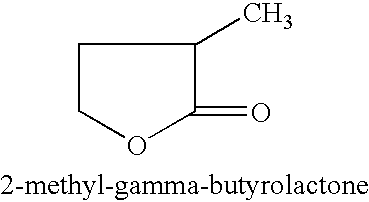Manufacture of 3-methyl-tetrahydrofuran from 2-methyl-gamma-butyrolactone
- Summary
- Abstract
- Description
- Claims
- Application Information
AI Technical Summary
Benefits of technology
Problems solved by technology
Method used
Image
Examples
examples 1-64
Reduction of 2-methyl-gamma-butyrolactone to 3-methyl-tetrahydrofuran
[0030] 50% 2-methyl-gamma-butyrolactone in dioxane (970.0 mg, 4.84 mmole) and an amount of catalyst and support as indicated in Table 1, were added to a 2 ml reactor. The reactor was sealed and charged with 6.89 MPa of H.sub.2, and heated to 225.degree. C. then cooled rapidly. The reaction was stopped after 4 hours. An internal standard (2-methoxy ethyl ether) was added to the reaction mixture and GC analysis was performed on a HP-6890 GC with a Chrompack column (CP-WAX 58, 25 M.times.0.25 MM). An acid promoter was not used for examples 1-33. An acid promoter was used for examples 34-66.
2TABLE 1 H.sub.2 2-Me-GBL 3-methyl-Ex. Time Temp. Pressure Catalyst / Conversion tetrahydrofuran No. (hrs) (.degree. C.) (MPa) Support Acid (%) Selectivity (%) 1. 4 225 6.89 1% Ru / 6% Re / C 19.56 49.12 2. 4 225 6.89 5% Rh / Sibunit C 9.21 12.76 3. 4 225 6.89 5% Pt / Sibunit C 2.12 29.23 4. 4 225 6.89 5% Ru / Calsicat C 9.87 77.56 5. 4 225 6....
PUM
 Login to View More
Login to View More Abstract
Description
Claims
Application Information
 Login to View More
Login to View More - R&D
- Intellectual Property
- Life Sciences
- Materials
- Tech Scout
- Unparalleled Data Quality
- Higher Quality Content
- 60% Fewer Hallucinations
Browse by: Latest US Patents, China's latest patents, Technical Efficacy Thesaurus, Application Domain, Technology Topic, Popular Technical Reports.
© 2025 PatSnap. All rights reserved.Legal|Privacy policy|Modern Slavery Act Transparency Statement|Sitemap|About US| Contact US: help@patsnap.com



